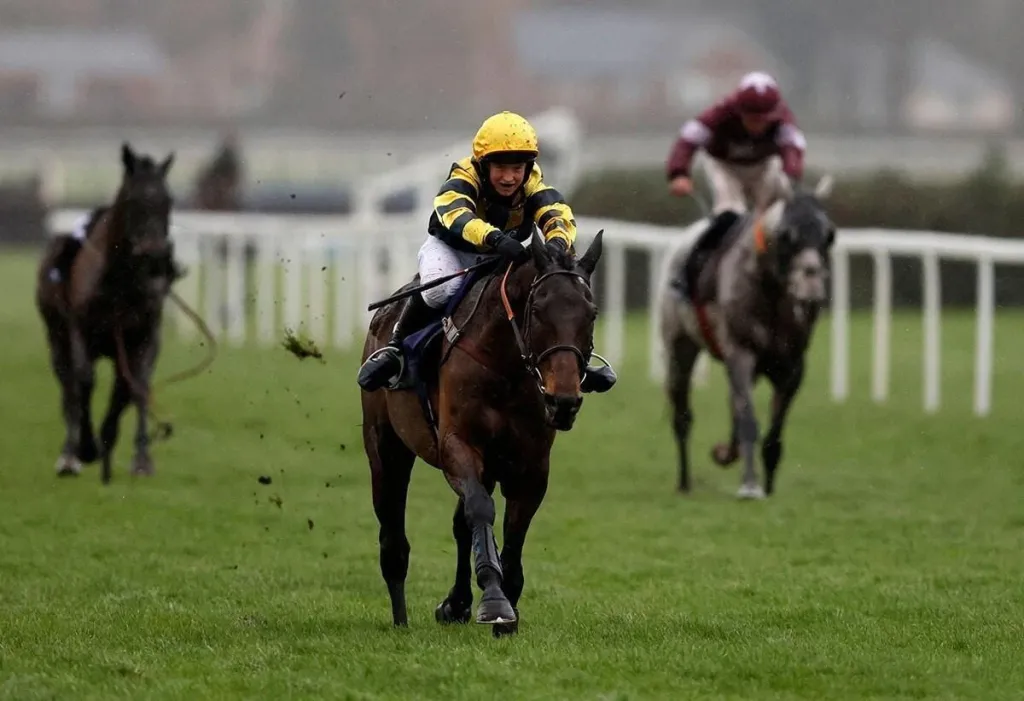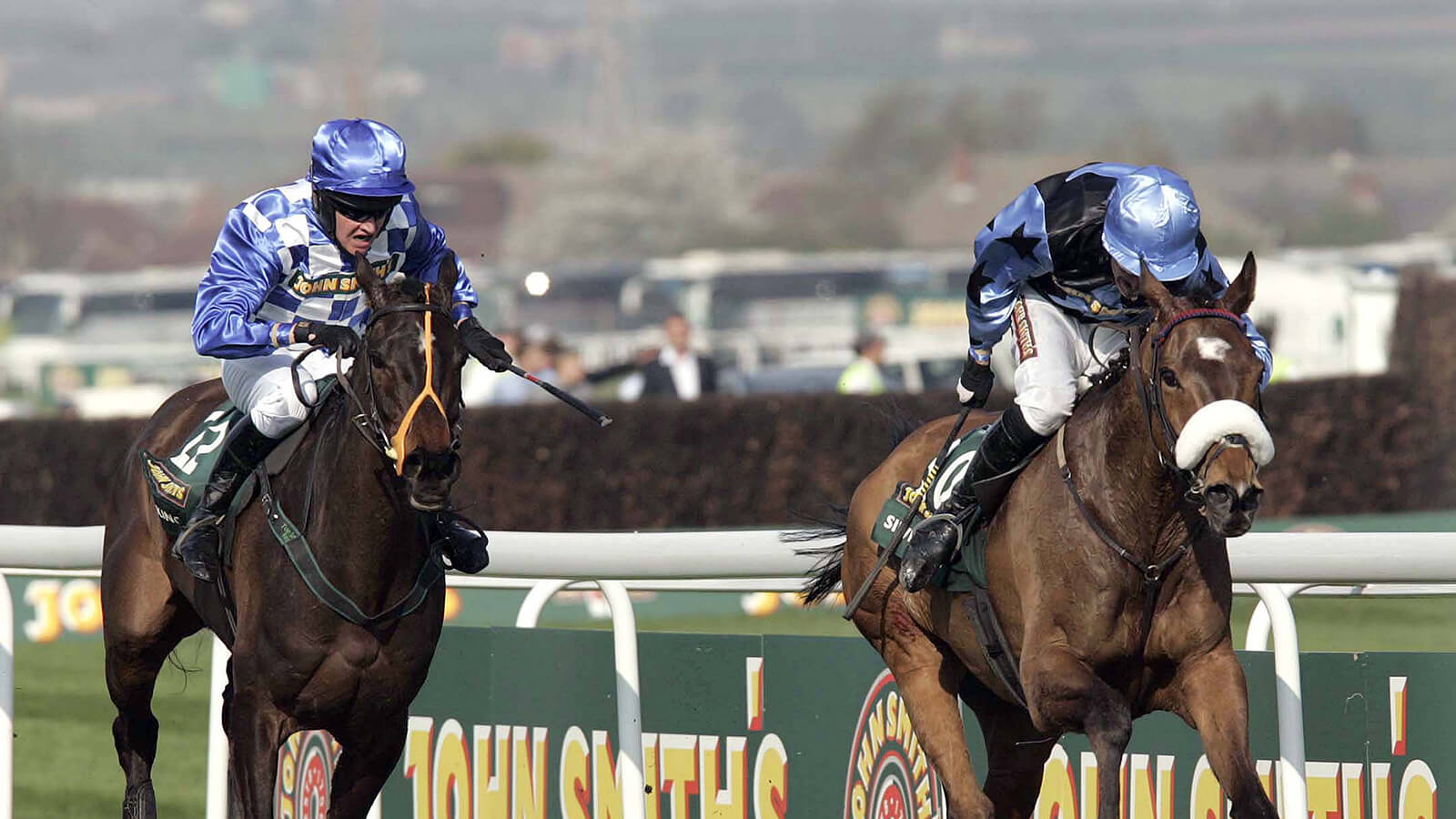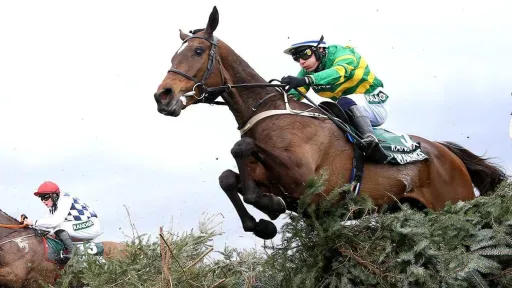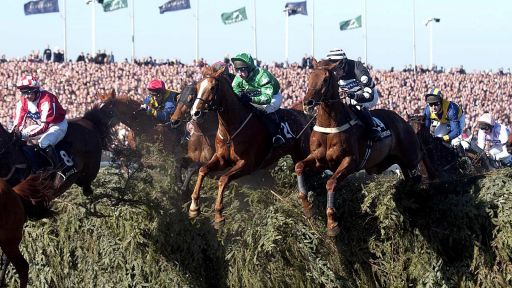How does the Becher Chase fare as a trial for the Grand National?

The Becher Chase as a trial for the Grand National
Three horses have completed a Becher Chase and Grand National double. However, none of those doubles was achieved in the same season.
Nigel Twiston-Davies’ Earth Summit won the Grand National in 1998 and then went on to take the Becher Chase the season afterwards.
Ginger McCain’s Amberleigh House (pictured above) took the Becher Chase in 2001 but didn’t go on to win the Grand National till 2004.
It’s a similar story for Silver Birch who won the Becher Chase in 2004 for Paul Nicholls but didn’t win the Grand National until moving to Gordon Elliott in 2007.

Silver Birch (right) battles with Slim Pickings to win the 2007 Grand National
Every year the horse that wins the Becher Chase is elevated to very near the top of the market for the Grand National but, as yet, no horse has pulled off the big race double in the same season.
The Becher Chase runners who go on to run well in the Grand National
Whilst Becher Chase winners have failed to go on and win the Grand National in the same season, those that have run in the Becher but did NOT win there have gone on to win or place in the Grand National. However, no Becher Chase runner since Walk In The Mill in 2018/19 has subsequently run well in the following Grand National.
The following horses in the last ten years have run in the earlier race and then made the 1-2-3-4-5 slots in the Grand National:
| Season | Horse | Becher Chase finishing position | Grand National finishing position |
|---|---|---|---|
| 2018/19 | Walk In The Mill | 1st | 4th |
| 2016/17 | One For Arthur | 5th | 1st |
| 2016/17 | Saint Are | Fell | 3rd |
| 2015/16 | Vics Canvas | 5th | 3rd |
| 2015/16 | Goonyella | 9th | 5th |
| 2014/15 | Saint Are | 3rd | 2nd |
| 2013/14 | Pineau De Re | Fell | 1st |
Grand National winners can emerge from the Becher Chase as there have been two Grand National victors in the last ten runnings that had run in the shorter race earlier in the season:
One For Arthur finished fifth in the Becher in the 2016/17 season before going on to victory in the Grand National later that season.
Pineau De Re was noted making progress when falling at the eighth fence in the 2013 Becher Chase but then went on to win the National in 2014.
However, with the increased dominance of Irish horses in the Grand National, the influence of the Becher Chase may be diminishing. Here are the finishing positions of horses over the last three renewals who ran in both the Becher Chase and the Grand National in the same season:
2022/23
- Fortescue- 4th Becher Chase, 13th Grand National
- Hill Sixteen - 7th Becher Chase, Fell Grand National
- Recite A Prayer - 12th Becher Chase, Unseater Rider Grand National
- Francky Du Berlais - 15th Becher Chase, 16th Grand National
2021/22
- Snow Leopardess - 1st Becher Chase, Pulled Up Grand National
- Domaine De Lisle - 4th Becher Chase, Unseated Rider Grand National
- Top Ville Ben - Fell Becher Chase, Pulled Up Grand National
2020/21
- Vieux Lion Rouge - 1st Becher Chase, Fell Grand National
- Kimberlite Candy - 2nd Becher Chase, Pulled Up Grand National
- Jett - 8th Becher Chase, 8th Grand National
- Yala Enki - Fell Becher Chase, Unseated RIder Grand National
- Minellacelebration - Unseated Rider Becher Chase, Unseated Rider Grand National
What factors are different in the Becher Chase and the Grand National?
The principle differences between the Becher Chase and the Grand National are that the National is run over a mile further and that nine extra fences are jumped. But what are the other factors that differentiates the two races?
- 1. Course Layout
The Becher Chase is currently run over just under three miles and two furlongs and the race starts in a completely different part of the track compared to the Grand National. The first fence in the Becher Chase is the plain fence that comes after Valentines in the National. The Booth open ditch is jumped before another plain fence. The Becher Chase field then has quite a run before the next obstacle after crossing the Melling Road. This gives the Becher field a chance to compose themselves and get into a position before tackling the two fences before The Chair. In contrast in the National, the field have six fences that come in close succession from the starting tape, concluding with the most famous Aintree fence of all; Bechers Brook. This combination of high pace and the string of big fences in quick succession from the start may not be to every horse's liking, especially given the very large number of runners. In contrast, the smaller fields of the Becher Chase means horses have a chance to spread out easier and have a clearer view of the fences as they approach.
- 2. Different ground conditions
Becher Chases are often run on soft or heavy ground whereas, traditionally the Grand National tends to take place good to soft Not all horses can show their best form irrespective of the underfoot conditions and very few competitors will be able to switch from the usual very soft conditions in December to the likely good to soft/good ground on offer in April and retain their form at the highest level.
- 3. Field size
Another aspect that makes achieving good performances in both races difficult is the size of the relative fields. Since 2000, the Grand National has not been run with any less than thirty-eight runners whereas in the same time period the Becher has only had more than twenty runners five times and had a field with only eight runners in 2009.
- 4. Pace
Obviously the smaller field (and the slower ground) tends to mean the pace the Becher Chase is run at tends to be more realistic compared to the often hell for leather speed that the Grand National is run at, particularly over the first few fences. Jockeys tend to be very keen to be near the leaders in the Grand National and this can mean an unrealistically fast early pace for a race run over a marathon distance. Horses who run in the Grand National tend to be types who rely on their stamina and would be used to taking their time to warm up over the early fences so may find everything happening too quickly for them early on in a Grand National.
How did recent Becher Chase winners get on when running in the Grand National?
2023 Becher Chase winner Chambard
Chambard won an attritional Becher Chase that was run in heavy ground where only twelve horses lined up and only five completed the course. Amateur rider Lucy Turner steered the eleven-year-old to victory and in doing so became the first lady rider to win a race over the Grand National fences. Chambard was all set to line up in the 2024 Grand National but was found to be lame just before the big race so did not get a chance to complete the Becher/Grand National double.
2022 Becher Chase winner Ashtown Lad
Despite winning the 2022 Becher Chase, trainer Dan Skelton voiced reservations about his horse staying the Grand National trip. As a result, Ashtown Lad was aimed at the Topham instead where he was pulled up
2021 Becher Chase winner Snow Leopardess:
The Charlie Longsdon trained Snow Leopardess was a game short-head winner in last year's Becher Chase on soft ground, with the front two pulling sixteen lengths clear of the rest of the field.
Understandably the bookmakers reacted accordingly by cutting Snow Leopardess into ante-post favourite for the Grand National.
Based on her Becher Chase victory (and subsequent success in a Mares’ Listed race) the handicapper raised Snow Leopardess's mark by six pounds for the National. The betting public sent the grey mare off the third favourite at 10/1 but Snow Leopardess ran a very lacklustre race and was beaten by as early as the seventh fence. In the Becher Chase she had been prominent from the start and had led the field from the sixth fence.
Perhaps it was the change from soft ground in the Becher to spring good to soft ground in the National, the increased handicap mark or the bigger field size and pace set up of the Grand National that was her downfall but Snow Leopardess did not get competitive at any stage in the longer race.
2020 and 2016 Becher Chase winner Vieux Lion Rouge
Vieux Lion Rouge has become part of Aintree folklore in that he has jumped more Grand National fences than any other horse in history.
Now retired, the former David Pipe trained gelding racked up a lot of those jumps in the Becher Chase in which he competed in six consecutive years, winning the race twice in 2016 and 2020.
In 2016, Vieux Lion Rouge won the Becher Chase as a novice, staying on doggedly to wrestle victory from Highland Lodge by a short-head. After that win, trainer Pipe decided to approach the Grand National with a fresh horse and didn't run the gelding until lining up again at Aintree in April. In the National itself in 2017, 12/1 shot Vieux Lion Rouge appeared to be going to take a leading hand in the race when moving into second place after the third last fence but eventually his stamina gave out to finish twenty-seven lengths behind winner One For Arthur in sixth place. The irony for the Pipe horse's supporters was that One For Arthur had finished fifth behind Vieux Lion Rouge in the aforementioned Becher Chase.
In 2017 in the Becher Chase, Vieux Lion Rouge finished a distant seventh behind Blaklion, in the 2018 Becher Chase the Pipe chaser was back to form finishing four and a half lengths second behind Walk In The Mill and then in 2019 the same horse had Vieux Lion Rouge nearly thirty lengths behind in ninth place.
In 2020, the handicapper relented and returned Vieux Lion Rouge a lower mark than his 2016 victory in the Becher Chase and this seemed to do the trick as the gelding ran out a devastating twenty-four length winner. Despite the nature of this wide-margin victory, the betting public allowed Vieux Lion Rouge to go off at 66/1 in the Grand National itself where the gelding fell for the first time in all his attempts at over the big Aintree fences.
David Pipe allowed the horse one last hurrah in the 2021 Becher Chase but Vieux Lion Rouge was twelve-years-old by this point and didn't jump with anything like his usual fluency and eventually unseated Tom Scudamore after the twelfth fence.
Ultimately, despite Vieux Lion Rouge's superb jumping over the National fences, it was the extra mile of the National that was his undoing when trying to achieve the Becher Chase/Grand National double.
2019 and 2018 Becher Chase winner Walk In The Mill
Walk In The Mill ran in the Becher Chase three times, winning in both 2018 and 2019 and falling in 2020. He is only the third horse to win the race more than once.
In 2018 he was a 10/1 shot having previously won a handicap chase at Ascot a month before Aintree. Under a strong ride from James Best, Walk In The Mill was driven out for a four and a half lengths victory over Vieux Lion Rouge. Following his Becher Chase win trainer Robert Walford decided to protect his gelding’s handicap mark for the Grand National and ran Walk In The Mill in a couple of novice hurdles to keep his fitness up. Unfortunately for Walk In The Mill’s connections he came up against Tiger Roll in the Grand National but their gelding showed excellent stamina to stay on for fourth place, some sixteen lengths behind the impressive winner and in doing so achieved the best placing in the Grand National of any Becher Chase winner in the last ten years.
In 2019 Walk In The Mill was sent off at 8/1 for his second shot at the Becher Chase and trainer Walford’s addition of first time cheekpieces did the trick with Walk In The Mill who had disappointed on his seasonal reappearance when pulling up. The headgear worked the oracle and the then nine-year-old stayed on well to take the race for the second time.
Robert Walford decided to take the same Grand National prep route as the year before by running Walk In The Mill in a novice hurdle at Chepstow where he finished second. Unfortunately the gelding picked up an injury after that race and was unable to run in the Grand National in 2020.
Walk In The Mill came back from that injury in October 2020 but didn’t appear to have retained his previous level of ability. He finished well beaten on his reappearance at Ascot and then had a heavy fall at Aintree when going for his third consecutive Becher Chase. The gelding only ran once more after that in the Classic Chase at Warwick where he was under pressure from a very early stage and was pulled up. After the race trainer Walford retired the horse as he felt the bad fall at Aintree may have tempered the horse’s enthusiasm for racing and jumping fences.
2017 Becher Chase winner Blaklion
Blaklion is different to the horses outlined above as he ran in the Grand National before running in a Becher Chase.
The son of Kayf Tara was a classy novice winning twice at Grade 2 level over hurdles and then taking the Grade 1 RSA Chase at Cheltenham in 2016. He ran well over fences in his first year out of novice status finishing fourth in the Charlie Hall, fifth in the Hennessy Gold Cup, third in the Rowland Meyrick and second in the Grand National Trial at Haydock. On the strength of those good runs, and the likelihood that a greater test of stamina was likely to suit the horse, he was sent off the 8/1 favourite for the 2017 Grand National. Favourite backers were certainly on good terms with themsleves when Blaklion took up the running at the fifth last fence and kicked clear. However, Blaklion's stamina seemed to give out between the last two fences and he eventually finished a tired fourth, just under nine lengths behind the winner, One For Arthur.
The following season Blaklion reappeared again at Wetherby in the Charlie Hall and ran a great race to finish second to Bristol De Mai. All roads then led back to AIntree for the Becher Chase where he was sent off at 7/4, the shortest price favourite in the race's history. The market faith in the horse proved to be correct as the then eight-year-old gelding powered away from the rest of the field to win by a very easy nine lengths. That facile victory resulted in an eight pound rise in the handicap for the Grand National but Blaklion's supporters were immediately disappointed there as the gelding was brought down at the first fence.
Blaklion tried again in the 2018 Becher Chase where he was sent off the 9/2 favourite but a repeat victory looked unlikely from an early stage and he eventually finished over sixty lengths behind eventual winner, Walk In The Mill. An injury that season put paid to any attempts at the Grand National with the gelding eventually being off the track for twenty months between February 2019 and October 2020.
Blaklion has tried the Grand National two further times since being moved to the Dan Skelton yard, finishing sixth in 2021 and fourteenth in 2022.
Recent winners of the Becher Chase
The table below highlights the last ten winners of the Becher Chase:
| Year | Winner | Age | Weight | SP | Trainer | Jockey |
|---|---|---|---|---|---|---|
| 2024 | Race Abandoned | | | | | |
| 2023 | Chambard | 11yo | 10-01 | | Venetia Williams | Lucy Turner |
| 2022 | Ashtown Lad | 8yo | 11-05 | | Dan Skelton | Harry Skelton |
| 2021 | Snow Leopardess | 9yo | 10-04 | | Charlie Longsdon | Aidan Coleman |
| 2020 | Vieux Lion Rouge | 11yo | 10-07 | | David Pipe | Conor O'Farrell |
| 2019 | Walk In The Mill | 9yo | 10-08 | | Robert Walford | James Best |
| 2018 | Walk In The Mill | 8yo | 10-03 | | Robert Walford | James Best |
| 2017 | Blaklion | 8yo | 11-06 | | Nigel Twiston-Davies | Gavin Sheehan |
| 2016 | Vieux Lion Rouge | 7yo | 10-09 | | David Pipe | Tom Scudamore |
| 2015 | Highland Lodge | 9yo | 10-00 | | James Moffat | Henry Brooke |
| 2014 | Oscar Time | 13yo | 10-12 | | Robert Waley-Cohen | Sam Waley-Cohen |


